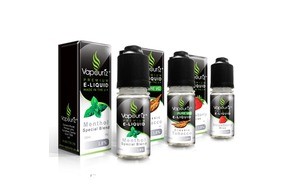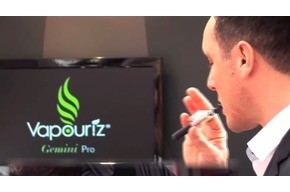Despite our growing knowledge that smoking is bad for us, many people continue to be tobacco cigarette smokers. Smoking is known to cause damage to every organ in the body, and smoking-related illnesses cause one in five deaths in the US. However, almost 70 percent of smokers report they want to quit, but find it very challenging.


Recent years has seen the rise of the e-cigarette, with one in 5 smokers trying smokeless products in an attempt to quite smoking regular cigarettes. E-cigarettes run on a battery - so there's nothing to smouldering ash. When you inhale an e-cigarette the battery powers the device to heat the e-liquid and vaporise it. E-cigarettes are therefore not burning tobacco so there's no tobacco smoke, which means no odour and no carbon monoxide. (The smoke exhaled is water vaper and the scent is dependant on the flavour of e liquid.)
E-cigarettes are tobacco-free, however they may contain nicotine. E-cigarette liquid is usually a combination of nicotine, flavourings, PG -propylene glycol (In most liquids), and VG - vegetable glycerin. How much nicotine is in the product depends on the mixture of the particular liquid-nicotine cartridge. Some e-liquid products contain the same amount of nicotine as regular tobacco products (2.4% / 1.8%), and others have levels more akin to that of a light or ultralight cigarette (1.2% / 0.6%). There are some cartridges available that are just flavoured liquid without nicotine, for users who want to mimic the experience of smoking a cigarette without the nicotine hit.
Despite these clear benefits, there has been much attention paid to creating the image of e-cigarettes as being toxic and unsafe. However, in the opinion of the Electronic Cigarette and Trade Association (ECITA), European officials have been wrongly labelling e-liquid as extremely toxic, and this may have greatly contributed to the negative media perception.
Incorrect Classification
There has been a great deal of speculation about how nicotine products for use in electronic cigarettes or e-liquids should be classified under the European Regulation (EC) No 1272/2008 on classification, labelling and packaging of substances and mixtures (CLP). There has been not only significant variation between advice given by regulators in different EU member states, but also from external sources.
ECITA sought clarification on the toxicity of the product, obtaining a report by toxicology consultants bibra (http://www.bibra-information.co.uk/company_overview.html) and having it verified by Professors Riccardo Polosa, Bernd Mayer, and Dr Jacques Le Houezec in order to get a scientifically accurate answer.


The Toxicology Report
The Bibra report is available online. As a general summary, Bibra calculated that, based on data contained in the CLP regulation, the acute oral and dermal toxicity of e-liquids of less than 2.5% are not classified under CLP, and that e-liquids of 2.5 to 5% are classified as category 4 - the lowest category.
Officials of the EU have been misclassifying e-liquid as either a CLP category 2 product (a category including strychnine), or a category 3 product (which includes formaldehyde).
This is surprising to those in the e-cigarette industry. While they are aware that media and regulatory attention dictating the risks of nicotine solutions were exaggerated, they did not think they could be so far from the truth.
Professional opinion
Bibra undertake in-house peer review in order to ensure their results are of good quality, but given the nature of this result, they felt that they needed to take wider consultation in order to ensure that the classification was appropriate. They approached three people, in three member states, with specific expertise in nicotine, but from different perspectives. They all approved the Libra report and agreed that the categorisation of e-liquids under the rules of the CPL were incorrect.
Professor & Chairman of the Department of Pharmacology and Toxicology at Karl-Franzens-University, Graz Professor Bernd Mayer, said:
“In his report, Peter Watts discusses the LD50 values of nicotine reported for different species. For the calculation of ATE [Acute Toxicity Estimate] he uses the widely accepted oral LD50 for rats (50 mg/kg). Taking the rat LD50 is generally accepted even at courts and every toxicologist will follow this rule. So Peter Watts’ calculation is definitively correct.”
Professor of Internal Medicine at the University of Catania, Professor Riccardo Polosa, said:
“After careful crosschecking of the calculations and verification of the ensuing reclassification, it is clear that the approach, calculations and re classifications given in the Bibra Proposal are correct.”
Independent Consultant in Public Health and Tobacco Dependence, and Honorary Lecturer at the UK Centre for Tobacco Control Studies, University of Nottingham, Dr Jacques Le Houezec, responded:
“The Bibra report presents the calculations based on different dilutions, including those used for e-liquids. It clearly shows that the current CPL regulation is not following the principles of EC Regulation 1272/2008.”
Conclusion
The conclusion of the Libra report and expert opinion is that all e-liquids with a concentration of less than 2.5% (25 mg/ml) should not be classified under the EC regulation, and that higher nicotine concentrations (up to 5% or 50 mg/ml for dermal classification, and even higher for oral classification) should only be be considered as CPL category 4, or as dangerous as using washing up liquid.
The upshot of all this is that electronic cigarettes are a viable and healthier alternative to tobacco, as many vapers already knew. Whilst we at Vapouriz feel that some regulation of e liquid is a good thing, there does need to be accurate classification for that to happen. Maintaining a quality standard is a very good thing and will hopefully limit any less-than-perfect samples from being available. The most important thing is that the vaper gets the best quality product available and consistency. But the health connotations of tobacco over e liquid speak for themselves and every vaper who is an ex-tobacco smoker will have seen this first hand.


